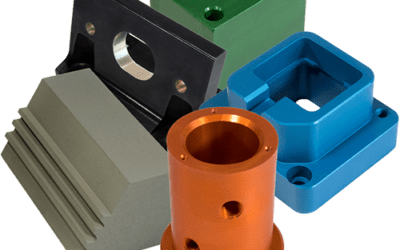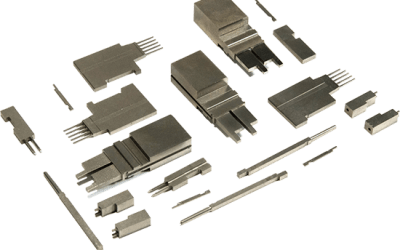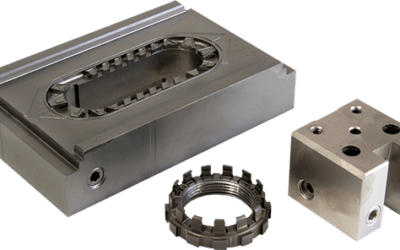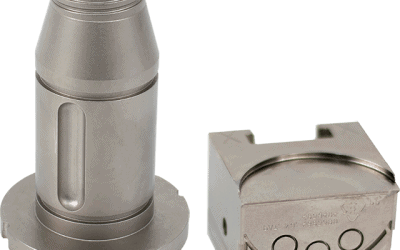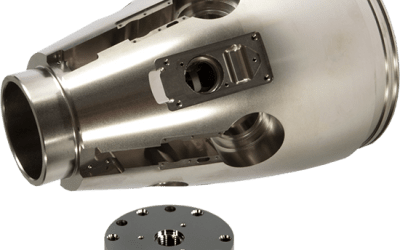Choosing a High Phosphorus Electroless Nickel Plating Process for Your Application

Protect Your Parts from Corrosion with Electroless Nickel Coating
The process of electroless nickel plating deposits an even layer of nickel-phosphorus alloy to the surface of the substrate resulting in a material with exceptional uniformity. High phosphorus electroless nickel plating offers superior corrosion protection with approximately 1,000 hours of salt spray protection for parts up to .001” thickness. This versatile coating process is used on a variety of metals including almost all cold steels, copper, and aluminum. Electroless nickel plating is perfect for repairing molds, bores, EDM areas, and bringing parts back to print dimension. This process can also be used to salvage or extend the life of tools and parts especially from the effects of high chloride environments and repeated exposure to outdoor environmental elements.
Electroless Nickel Plating vs. Electrolytic Nickel Plating
Electroless nickel plating is one of two primary nickel plating options, the other is called electrolytic or electro nickel plating. In its paper, “Properties and Applications of Electroless Nickel,” the Nickel Institute differentiates between the two processes, “Electroless nickel plating is a process for depositing a nickel alloy… onto a substrate without the use of electric current. It differs, therefore, from electroplating, which depends on an external source of direct current.”
Thomasnet.com points out “for most applications, the uniformity of electroless nickel plating is the main reason manufacturers use the process. This is opposed to electro nickel plating, which often results in thicker deposit build-ups around the edges and corners of the base material.”
As a result, electroless nickel plating is often preferred over other plating services and processes in applications where corrosion protection, precision, and wear resistance are required, such as oilfield valve applications, drive shafts, and mechanical tools and equipment.
Exploring Benefits of Electroless Nickel Plating
Electroless nickel plating is widely used as a functional coating in the electronics, oil and gas, chemical, aerospace and automotive industries, and many others for numerous applications.
The advantages of electroless nickel plating include:
- Excellent corrosion protection – The electroless nickel plating process utilizes phosphorus which boosts corrosion resistance. This is important in applications where rust prevention is critical.
- High-temperature melting range – Electroless nickel plating results in a unique melting range dependent on the level of phosphorus in the compound. The melting point decreases as phosphorus levels increase, resulting in improved solderability or high-temperature resistance depending upon what an application requires.
- Even coating to repair your parts – Complex parts featuring recesses, ridges, or grooves require electroless nickel plating for restoration to ensure they meet precise requirements.
- Increased durability, lubricity, ductility – Electroless nickel plating results in parts that offer less friction against other materials. They are also less likely to crack, break, or shatter under stress.
- Improved hardness – For applications requiring finished products with durable surfaces, electroless nickel plating results in hard, wear-resistant, and abrasion-resistant surfaces.
- Greater coating versatility – Progress for Industry, Inc. (PFI) offers plating services that can plate electroless nickel as thin as 0.000025” and as thick as .020”, addressing a wide variety of applications including CNC machining, military applications, and the injection mold industry.
When to Choose Electroless Nickel Plating
Both electroless nickel plating and electrolytic nickel plating deliver a coating of nickel to the surface of various parts. Electroless plating offers superior corrosion protection and increased durability, lubricity, ductility, hardness, and versatility, while electroless nickel plating applies uniform layers of nickel, best for precision parts and applications. Additionally, the percentage of phosphorus used in the electroless nickel plating process can influence the metallurgical properties of the resulting coating. This further broadens the scope of applications for which electroless nickel plating can be used compared to other plating processes and results in three primary plating services known as electroless nickel baths:
- High phosphorus electroless nickel plating – Results in materials known for superior corrosion protection. These are preferred in applications such as coal mining and oil drilling where parts are exposed to highly corrosive or acidic environments.
- Medium phosphorus electroless nickel plating – The most common nickel bath, this coating is known for its fast plating rate. It is used where hardness or brightness is required, such as electric, industrial, or decorative applications.
- Low phosphorus electroless nickel plating – Results in a coating measuring very high on the Rockwell scale (RC) for hardness. It is applicable in any application requiring exceptional strength and durability.
Choosing an Electroless Nickel Plating Partner
PFI is a top electroless nickel plating supplier that specializes in high-quality, tight-tolerance plating services focused on engineering applications, tooling protection, and more. PFI addresses a variety of applications across CNC machining, military, and injection mold industries. PFI carefully masks and selectively plates only the area requiring coating.
With high phosphorus, medium phosphorus, and low phosphorus electroless nickel plating baths, PFI has the capabilities to apply electroless nickel plating to any of the following materials: Carbon, stainless steel, high alloy steel, iron, aluminum, copper, brass, bronze, and beryllium.
Contact PFI for a quote today.
